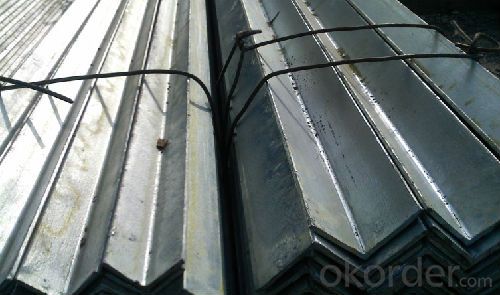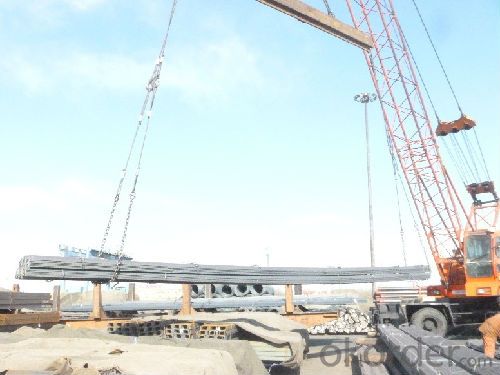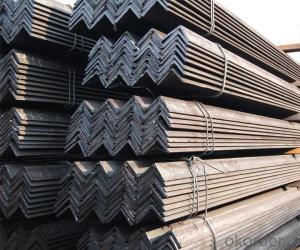Unequal Steel Angle S235jrg Hot Dip Galvanized
- Loading Port:
- Tianjin
- Payment Terms:
- TT or LC
- Min Order Qty:
- 30 m.t.
- Supply Capability:
- 35000 m.t./month
OKorder Service Pledge
OKorder Financial Service
You Might Also Like
Product Description:
OKorder is offering Unequal Steel Angle S235jrg Hot Dip Galvanized at great prices with worldwide shipping. Our supplier is a world-class manufacturer of steel, with our products utilized the world over. OKorder annually supplies products to European, North American and Asian markets. We provide quotations within 24 hours of receiving an inquiry and guarantee competitive prices.
Product Applications:
Unequal Steel Angle S235jrg Hot Dip Galvanized are ideal for structural applications and are widely used in the construction of buildings and bridges, and the manufacturing, petrochemical, and transportation industries.
Product Advantages:
OKorder's Unequal Steel Angle S235jrg Hot Dip Galvanized are durable, strong, and resist corrosion.
Main Product Features:
· Premium quality
· Prompt delivery & seaworthy packing (30 days after receiving deposit)
· Corrosion resistance
· Can be recycled and reused
· Mill test certification
· Professional Service
· Competitive pricing
Product Specifications:
Specification:GB/EN/ASTM/JIS/ S275JR
Grade:A36,SS400,Q235,Q345,ST37,ST52
Zinc thickness:30-100um(200-600g/m2)
Size: from Size 25--Size 100
FAQ:
Q1: Why buy Materials & Equipment from OKorder.com?
A1: All products offered byOKorder.com are carefully selected from China's most reliable manufacturing enterprises. Through its ISO certifications, OKorder.com adheres to the highest standards and a commitment to supply chain safety and customer satisfaction.
Q2: How do we guarantee the quality of our products?
A2: We have established an advanced quality management system which conducts strict quality tests at every step, from raw materials to the final product. At the same time, we provide extensive follow-up service assurances as required.
Q3: How soon can we receive the product after purchase?
A3: Within three days of placing an order, we will begin production. The specific shipping date is dependent upon international and government factors, but is typically 7 to 10 workdays.
Images:



- Q:Can steel angles be used in residential construction?
- Yes, steel angles can be used in residential construction. Steel angles are versatile structural elements that are commonly used in various construction applications, including residential buildings. They are often used for framing, reinforcing, and providing structural support in walls, roofs, and floors. Steel angles are preferred in residential construction due to their strength, durability, and ability to withstand heavy loads. They can be easily welded, bolted, or screwed into place, making them suitable for a wide range of construction projects. Additionally, steel angles can be galvanized or coated to enhance their resistance to corrosion, ensuring their longevity. Overall, steel angles are a reliable and cost-effective choice for residential construction.
- Q:How do steel angles resist bending or deflection?
- Steel angles resist bending or deflection due to their shape and material properties. The L-shape of steel angles provides structural rigidity, preventing excessive bending or deflection under load. Additionally, the high tensile strength and stiffness of steel as a material enable angles to withstand external forces and distribute them evenly, ensuring minimal bending or deflection.
- Q:How do you determine the appropriate size of steel angle for a specific application?
- To determine the appropriate size of steel angle for a specific application, factors such as the load it needs to bear, the length of the span, the type of material being supported, and any applicable building codes or regulations should be considered. Structural engineers or professionals with expertise in steel construction can perform calculations and analysis to determine the required size of steel angle based on these factors.
- Q:Can steel angles be painted over?
- Yes, steel angles can be painted over. Prior to painting, it is important to ensure that the surface is clean and free from any dirt, oil, or rust. This can be achieved by using a wire brush or sandpaper to remove any loose particles and then wiping the surface with a clean cloth. Once the surface is properly prepared, a primer specifically designed for metal surfaces should be applied to promote adhesion and prevent corrosion. After the primer has dried, a suitable paint can be applied using a brush, roller, or spray gun. It is recommended to use paints that are specifically formulated for metal applications to ensure proper adhesion and durability. Regular maintenance and repainting may be required over time to maintain the appearance and protect the steel angles from corrosion.
- Q:Can steel angles be used in architectural applications?
- Yes, steel angles can be used in architectural applications. Steel angles are versatile structural components that can provide stability, support, and aesthetic appeal to various architectural designs. They can be used for framing, bracing, reinforcing, and creating unique shapes and forms in buildings, bridges, and other architectural structures.
- Q:What are the different fabrication techniques used for steel angles?
- There are several different fabrication techniques used for steel angles, depending on the specific requirements and desired outcome. Some of the commonly used techniques include: 1. Hot rolling: This is the most common fabrication technique for steel angles. In this process, the steel is heated above its recrystallization temperature and passed through a series of rollers to shape it into the desired angle profile. Hot rolling helps to improve the mechanical properties of the steel and provides a smooth surface finish. 2. Cold rolling: This technique is similar to hot rolling, but the steel is processed at room temperature. Cold rolling is often used to produce steel angles with tighter dimensional tolerances and improved surface finish. It also enhances the mechanical properties of the steel. 3. Laser cutting: Laser cutting is a precise and efficient fabrication technique used to cut steel angles into the desired shape and size. A high-powered laser beam is directed onto the steel, melting or vaporizing the material along the cutting path. Laser cutting offers excellent accuracy, speed, and versatility. 4. Welding: Welding is commonly used to join steel angles together or attach them to other structural components. Different welding techniques, such as arc welding, gas metal arc welding (MIG), or tungsten inert gas (TIG) welding, can be employed depending on the specific application and the desired strength of the joint. 5. Bending: Bending is another technique used to fabricate steel angles. It involves applying force to the steel to bend it into the desired angle shape. Bending can be done using various methods, including press brakes, rollers, or hydraulic machines. This technique is often used when precise angle measurements and specific radius requirements are needed. 6. CNC machining: Computer Numerical Control (CNC) machining is a highly precise and automated fabrication technique used to produce steel angles with complex shapes and intricate details. CNC machines use computer-controlled tools to remove material from the steel, creating the desired angle profile. Each fabrication technique has its own advantages and limitations, and the choice of technique depends on factors such as the required angle dimensions, tolerances, surface finish, and the intended application of the steel angles.
- Q:Can steel angles be used in the construction of shopping malls?
- Yes, steel angles can be used in the construction of shopping malls. Steel angles are commonly used in structural applications, including the construction of commercial buildings like shopping malls. They provide strength, stability, and support, making them a suitable choice for various structural elements such as frames, columns, and beams in shopping mall construction.
- Q:How do you measure the dimensions of a steel angle?
- To measure the dimensions of a steel angle, you would typically use a combination of tools such as a measuring tape or ruler, a protractor, and a square. First, you would measure the length of one side of the angle using a measuring tape or ruler. Place the tape or ruler along the side of the angle and note the measurement. Next, you would measure the length of the other side of the angle in the same manner. Make sure to measure from the same starting point as the first side to ensure accuracy. To measure the angle itself, use a protractor. Align the base of the protractor with one side of the angle and ensure that the other side is aligned with the correct degree marking on the protractor. Read the measurement on the protractor to determine the angle of the steel angle. Lastly, you can use a square to check if the angle is truly 90 degrees. Place the square against the two sides of the angle and ensure that it aligns perfectly with both sides. If it does, then the angle is indeed 90 degrees. It is important to note that these measurements may be approximate and may vary slightly due to manufacturing tolerances.
- Q:Are steel angles affected by creep?
- Yes, steel angles can be affected by creep. Creep is the tendency of a material to deform over time under a constant load or stress. While steel is known for its high strength and durability, it is not completely immune to creep. The extent of creep in steel angles will depend on various factors such as the specific type of steel, the temperature, and the applied load. Creep in steel angles can occur at elevated temperatures or when the load is sustained over a long period. When subjected to high temperatures, the atoms within the steel start to move more rapidly, leading to a gradual deformation of the material. This can be a concern in applications where steel angles are exposed to sustained high temperatures, such as in structural components of industrial furnaces or boilers. Additionally, sustained loads can also cause creep in steel angles. Over time, the constant stress on the material can lead to a slow and progressive deformation. This can be particularly significant in situations where the steel angles are subjected to heavy loads for extended periods, such as in long-span bridges or tall buildings. To mitigate the potential effects of creep, engineers and designers must consider the specific requirements of the application and select the appropriate type of steel angle and design parameters. They may also incorporate additional measures such as providing support or reinforcement to minimize the impact of creep on the structural integrity of the steel angles. Regular inspection and maintenance can also help identify any signs of creep and take necessary measures to address them.
- Q:How are steel angles installed on concrete structures?
- Steel angles are typically installed on concrete structures using anchor bolts. These anchor bolts are drilled into the concrete and then the steel angles are placed over these bolts. Nuts and washers are then tightened onto the anchor bolts to secure the steel angles in place.
1. Manufacturer Overview |
|
|---|---|
| Location | |
| Year Established | |
| Annual Output Value | |
| Main Markets | |
| Company Certifications | |
2. Manufacturer Certificates |
|
|---|---|
| a) Certification Name | |
| Range | |
| Reference | |
| Validity Period | |
3. Manufacturer Capability |
|
|---|---|
| a)Trade Capacity | |
| Nearest Port | |
| Export Percentage | |
| No.of Employees in Trade Department | |
| Language Spoken: | |
| b)Factory Information | |
| Factory Size: | |
| No. of Production Lines | |
| Contract Manufacturing | |
| Product Price Range | |
Send your message to us
Unequal Steel Angle S235jrg Hot Dip Galvanized
- Loading Port:
- Tianjin
- Payment Terms:
- TT or LC
- Min Order Qty:
- 30 m.t.
- Supply Capability:
- 35000 m.t./month
OKorder Service Pledge
OKorder Financial Service
Similar products
New products
Hot products
Related keywords



























